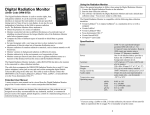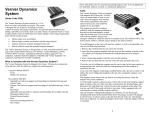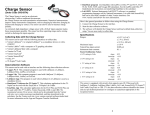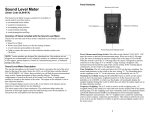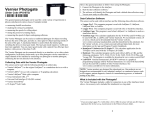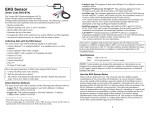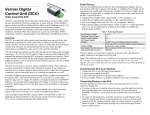Download the user manual for full specifications
Transcript
Conductivity Probe (Order Code CON-BTA) The Conductivity Probe can be used to measure either solution conductivity or total ion concentration of aqueous samples being investigated in the field or in the laboratory. Conductivity is one of the most common environmental tests of aquatic samples. Even though it does not tell you specific ions that are present, it quickly determines the total concentration of ions in a sample. It can be used to perform a wide variety of tests or planned experiments to determine the changes in or levels of total dissolved ions: Allow students to qualitatively see the difference between the ionic and molecular nature of electrolytes in aqueous solution. This can include differences in strength of weak acids and bases, or the number of ions that an ionic substance dissociates into per formula unit. Use the probe to confirm the direct relationship between conductivity and ion concentration in an aqueous solution. Concentrations of unknown samples can then be determined. Use this probe for an accurate, on-site measurement of total dissolved solids (TDS) in a stream or lake survey. Monitor the rate of a chemical reaction in which dissolved ions and solution conductivity varies with time due to an ionic species being consumed or produced. Use the Conductivity Probe to determine the rate at which an ionic species diffuses through a membrane, such as dialysis tubing. Collecting Data with the Conductivity Probe This sensor can be used with the following interfaces to collect data. Vernier LabQuest® 2 or original LabQuest® as a standalone device or with a computer Vernier LabQuest® Mini with a computer Vernier LabPro® with a computer or TI graphing calculator Vernier Go!®Link Vernier EasyLink® Vernier SensorDAQ® CBL 2™ TI-Nspire™ Lab Cradle Here is the general procedure to follow when using the Conductivity Probe: 1. Connect the Conductivity Probe to the interface. 2. Start the data-collection software1. 3. The software will identify the Conductivity Probe and load a default data-collection setup. You are now ready to collect data. Data-Collection Software This sensor can be used with an interface and the following data-collection software. Logger Pro 3 This computer program is used with LabQuest 2, LabQuest, LabQuest Mini, LabPro, or Go!Link. Logger Lite This computer program is used with LabQuest 2, LabQuest, LabQuest Mini, LabPro, or Go!Link. LabQuest App This program is used when LabQuest 2 or LabQuest is used as a standalone device. DataQuest™ Software for TI-Nspire™ This calculator application for the TI-Nspire can be used with the EasyLink or TI-Nspire Lab Cradle. EasyData App This calculator application for the TI-83 Plus and TI-84 Plus can be used with CBL 2, LabPro, and Vernier EasyLink. We recommend version 2.0 or newer, which can be downloaded from the Vernier web site, www.vernier.com/easy/easydata.html, and then transferred to the calculator. See the Vernier web site, www.vernier.com/calc/software/index.html for more information on the App and Program Transfer Guidebook. DataMate Use DataMate with LabPro or CBL 2 and TI-73, TI-83, TI-84, TI-86, TI-89, and Voyage 200 calculators. See the LabPro and CBL 2 Guidebooks for instructions on transferring DataMate to the calculator. LabVIEW National Instruments LabVIEW™ software is a graphical programming language sold by National Instruments. It is used with SensorDAQ and can be used with a number of other Vernier interfaces. See www.vernier.com/labview for more information. NOTE: Vernier products are designed for educational use. Our products are not designed nor recommended for any industrial, medical, or commercial process such as life support, patient diagnosis, control of a manufacturing process, or industrial testing of any kind. Taking Measurements with the Conductivity Probe Rinse the tip of the Conductivity Probe with distilled water. Optional: Blot the inside and outside of the electrode cell dry to avoid water droplets diluting or contaminating the sample to be tested. Insert the tip of the probe into the sample to be tested. Important: Be sure the electrode surfaces in the elongated cell are completely submerged in the liquid and that there are no bubbles around the electrode surface. 1 If you are using Logger Pro 2 with either a ULI or SBI, the sensor will not auto-ID. Open an experiment file for the Conductivity Probe in the Probes & Sensors folder. 2 While gently swirling the probe, wait for the reading on your data-collection device to stabilize. This should take no more than 5 to 10 seconds. Note: Do not completely submerge the sensor. The handle is not waterproof. Rinse the end of the probe with distilled water before taking another measurement. If you are taking readings at temperatures below 15°C or above 30°C, allow more time for the temperature compensation to adjust and provide a stable conductivity reading. Important: Do not place the electrode in viscous, organic liquids, such as heavy oils, glycerin (glycerol), or ethylene glycol. Do not place the probe in acetone or other organic solvents, such as pentane or hexane. Storage and Maintenance of the Conductivity Probe When you have finished using the Conductivity Probe, simply rinse it off with distilled water and blot it dry using a paper towel or lab wipe. The probe can then be stored dry. If the probe cell surface is contaminated, soak it in water with a mild detergent for 15 minutes. Then soak it in a dilute acid solution (0.1 M hydrochloric acid or 0.5 M acetic acid works well) for another 15 minutes. Then rinse it well with distilled water. Important: Avoid scratching the inside electrode surfaces of the elongated cell. This sensor is equipped with circuitry that supports auto-ID. When used with LabQuest 2, LabQuest, LabQuest Mini, LabPro, Go! Link, SensorDAQ, TI-Nspire™ Lab Cradle, EasyLink, or CBL 2™, the data-collection software identifies the sensor and uses pre-defined parameters to configure an experiment appropriate to the recognized sensor. Specifications Range of Conductivity Probe Low Range: Mid Range: High Range: 0 to 200 µS/cm (0 to 100 mg/L TDS) 0 to 2000 µS/cm (0 to 1000 mg/L TDS) 0 to 20,000 µS/cm (0 to 10,000 mg/L TDS) 13-bit Resolution (with SensorDAQ) Low Range: 0.05 µS/cm (0.025 mg/L TDS) Mid Range: 0.5 µS/cm (0.25 mg/L TDS) High Range: 5 µS/cm (2.5 mg/L TDS) 12-bit Resolution (with LabQuest 2, LabQuest, LabQuest Mini, LabPro, Go!Link, EasyLink, TI-Nspire™) Low Range: 0.1 µS/cm (0.05 mg/L TDS) Mid Range: 1 µS/cm (0.5 mg/L TDS) High Range: 10 µS/cm (5 mg/L TDS) 3 10-bit Resolution (with CBL 2™) Low Range: 0.4 µS/cm (0.2 mg/L TDS) Mid Range: 4 µS/cm (2.0 mg/L TDS) High Range: 40 µS/cm (20 mg/L TDS) Accuracy using factory calibration: ±8% of full-scale reading for low range ±3% of full-scale reading for mid range ±4% of full-scale reading for high range Accuracy using custom calibration: ±2% of full-scale reading for each range Response time: 98% of full-scale reading in 5 seconds, 100% of full-scale in 15 seconds Temperature compensation: automatic from 5 to 35°C Temperature range (probe can be placed in): 0 to 80°C Cell constant: 1.0 cm-1 Description: ABS body, parallel graphite electrodes Dimensions: 12 mm OD and 150 mm length Factory Calibration Values intercept (all ranges): 0.0 slope (low range): 65.7 slope (mid range): 960 slope (high range): 9000 How the Conductivity Probe Works The Vernier Conductivity Probe measures the ability of a solution to conduct an electric current between two electrodes. In solution, the current flows by ion transport. Therefore, an increasing concentration of ions in the solution will result in higher conductivity values. The Conductivity Probe is actually measuring conductance, defined as the reciprocal of resistance. When resistance is measured in ohms, conductance is measured using the SI unit, siemens (formerly known as a mho). Since the siemens is a very large unit, aqueous samples are commonly measured in microsiemens, or µS. Even though the Conductivity Probe is measuring conductance, we are often interested in finding conductivity of a solution. Conductivity, C, is found using the following formula: 1 cm C = G • kc 1 cm where G is the conductance, and kc is the cell constant. The cell constant is determined d = 1 cm for a probe using the following formula: kc = d /A Figure 1 where d is the distance between the two electrodes, and A is the area of the electrode surface. 4 For example, the cell in Figure 1 has a cell constant: kc = d / A = 1.0 cm / 1.0 cm2= 1.0 cm-1 The conductivity value is found by multiplying conductance and the cell constant. Since the Vernier Conductivity Probe also has a cell constant of 1.0 cm-1, its conductivity and conductance have the same numerical value. For a solution with a conductance value of 1000 µS, the conductivity, C, would be: C = G • kc = (1000 µS) X (1.0 cm-1) = 1000 µS/cm A potential difference is applied to the two probe electrodes in the Conductivity Probe. The resulting current is proportional to the conductivity of the solution. This current is converted into a voltage. Alternating current is supplied to prevent the complete ion migration to the two ABS body electrodes. As shown in the figure here, with each cycle of the alternating current, the polarity of the electrodes is reversed, which in turn reverses the direction of ion flow. This very important feature of the Conductivity Probe prevents most graphite electrodes electrolysis and polarization from occurring at the electrodes. Thus, the solutions that are being measured for conductivity are not fouled. It also greatly reduces redox products from forming on the relatively inert graphite electrodes. One of the most common uses of the Conductivity Probe is to find the concentration of total dissolved solids, or TDS, in a sample of water. This can be accomplished because there is generally a direct relationship between conductivity and the concentration of ions in a solution, as shown here. The relationship persists until very large ion concentrations are reached. Optional Calibration Procedure You do not have to perform a new calibration when using the Conductivity Probe for most experiments in the classroom. Each Conductivity Probe is programmed with an experimentally determined calibration before shipping it. This calibration is unique for each setting on the sensor. The factory calibrations work best if each setting is used in the appropriate range; i.e., use low for ~0 µS/cm to 200 µS/cm, use middle for 200 µS/cm to 2,000 µS/cm, and use high for 2,000 µS/cm to 20,000 µS/cm. However, if your experimental application requires more accurate readings, you should calibrate your sensor. The Conductivity Probe can be easily calibrated at two known levels, using any of the Vernier data-collection programs. The calibration units can be 5 µS/cm, dS/cm, mg/L, ppm, or ppt. For best results, it is recommended that the two-point calibration be performed using two standard solutions that bracket the expected range of conductivity or concentration values you will be testing. For example, if you expect to measure conductivity in the range of 600 mg/L to 1000 mg/L (TDS), you may want to use a standard solution that is 500 mg/L for one calibration point and another standard that is 1000 mg/L for the second calibration point. Make sure the correct switch setting is used for the middle range of conductivity. To Calibrate: 1. Select the conductivity range setting on the probe box: low = 0 to 200 µS, medium = 0 to 2000 µS, and high = 0 to 20,000 µS. Note: If you are not sure which setting to use, start with the high setting to get a sense of what region you may want to narrow into. Once this value is determined, then select the appropriate setting for your measurements. 2. Initiate the calibration procedure in the software. 3. Low Conductivity Standard Solution Calibration Point: Place the Conductivity Probe into a standard solution with a low conductivity value, such as an accurately prepared dilution of the sodium chloride standard that is supplied with your probe. Be sure the entire elongated hole with the electrode surfaces is submerged in the solution and that there are no bubbles along the electrode surface. Wait for the displayed voltage to stabilize. Enter the value of the standard solution in the appropriately chosen units. Note: Performing a zero point calibration is not recommended with conductivity sensors. It is preferred that you use a low standard calibration standard instead of a zero point. This is particularly important if you plan to use the low range of the sensor where the low calibration point is most critical. 4. High Conductivity Standard Solution Calibration Point: Place the Conductivity Probe into a standard solution with a high conductivity value, such as the sodium chloride standard that is supplied with your probe. Be sure the entire elongated hole with the electrode surfaces is submerged in the solution and that there are no bubbles along the electrode surface. Wait for the displayed voltage to stabilize. Enter the value of the standard solution. 5. You may wish to store this custom calibration if your software has this option. Maintaining and Replacing the Sodium Chloride Standard Calibration Solution If you choose to calibrate the Conductivity Probe, you will want accurate standard solutions. The 1000 µS/cm Standard that shipped with the Conductivity Probe will last a long time if you take care not to contaminate it with a wet or dirty probe as well as reduce its exposure to air. This is a good concentration to calibrate your Conductivity Probe in the middle range (0–2000 µS/cm). Vernier sells three Conductivity Standards, one appropriate for each range of the Conductivity Probe. These standards are available in 500 mL bottles. Order codes are: Low Range (150 µS/cm) CON-LST Medium Range (1413 µS/cm) CON-MST High Range (12880 µS/cm) CON-HST 6 You can also prepare your own standard solutions using solid NaCl. Use a container with accurate volume markings (e.g., volumetric flask) and add the amount of solid indicated in Table 1. Table 1 Add this amount of TDS and Conductivity values equivalent to NaCl to make the NaCl concentration in the first column: 1 liter of solution Total dissolved solids (TDS) 0.0474 g (47.4 mg/L) 50 mg/L as TDS 0.491 g (491 mg/L) 500 mg/L as TDS 1.005 g (1005 mg/L) 1000 mg/L as TDS 5.566 g (5566 mg/L) 5000 mg/L as TDS Conductivity (microsiemens/cm) 100 µS/cm 1000 µS/cm 2000 µS/cm 10,000 µS/cm Automatic Temperature Compensation Your Vernier Conductivity Probe is automatically temperature compensated between temperatures of 5 and 35°C. Note that the temperature of a solution is being read by a thermistor that extends into the space between the graphite electrodes. Readings are automatically referenced to a conductivity value at 25°C; therefore, the Conductivity Probe will give the same conductivity reading in a solution that is at 15°C as it would if the same solution were warmed to 25°C. This means you can calibrate your probe in the lab, and then use these stored calibrations to take readings in colder (or warmer) water in a lake or stream. If the probe was not temperature compensated, you would notice a change in the conductivity reading as temperature changed, even though the actual ion concentration did not change. If sample bottles are filled brim full, then a gas such as carbon dioxide, which is capable of forming ionic species in solution, is prevented from dissolving in the water sample. Since the probe has built-in temperature compensation, you can do your calibration in the lab. This means that even though you will be sampling in water that has a different temperature than your calibration temperature, the probe will take correct readings at the new sampling temperature. Sampling in Ocean Water or Tidal Estuaries: Salinity Salinity is the total of all non-carbonate salts dissolved in water, usually expressed in parts per thousand (1 ppt = 1000 mg/L). Unlike chloride (Cl-) concentration, you can think of salinity as a measure of the total salt concentration, comprised mostly of Na+ and Cl- ions. Even though there are smaller quantities of other ions in seawater (e.g., K+, Mg2+, or SO42-), sodium and chloride ions represent about 91 percent of all seawater ions. Salinity is an important measurement in seawater or in estuaries where freshwater from rivers and streams mixes with salty ocean water. The salinity level in seawater is fairly constant, at about 35 ppt (35,000 mg/L), while brackish estuaries may have salinity levels between 1 and 10 ppt. The salinity range of the Conductivity Probe is 0 to 10 ppt. Seawater has a salinity of 35 ppt, so any seawater samples will need to be diluted before making measurements with this sensor. We recommend that you dilute seawater samples (or other samples that initially give readings above 10 ppt) to 1/4 of their original concentration, then multiply their measured salinity reading by 4 to obtain a final salinity value, in ppt. Brackish water in coastal estuaries is often in the range of 0 to 10 ppt, well within the high range of the probe. Note: Vernier also sells a Salinity Sensor (order code SAL-BTA) with a range of 0 to 50 ppt. Some combinations of sensors interfere with each other when placed in the same solution. The degree of interference depends on many factors, including which combination of sensors is being used, which interface is being used, and others. For more information, see www.vernier.com/til/638/ Since there is no stored salinity calibration for a Conductivity Probe, perform a two-point calibration using 5 ppt and 10 ppt salinity standards. Make sure your sensor switch is on the high conductivity setting. You will need to prepare two standard solutions to calibrate for salinity: A low standard (5 ppt salinity), add 4.60 g of NaCl to enough distilled water to prepare 1 liter of solution. A high standard (10 ppt salinity), add 9.20 g of NaCl to enough distilled water to prepare 1 liter of solution. Sampling in Streams and Lakes More about Conductivity Using the Conductivity Probe with Other Vernier Sensors It is best to sample away from shore and below the water surface, if possible. In free-flowing streams, there will usually be good mixing of the water, so that samples taken near the current will be quite representative of the stream as a whole. If you are sampling an impounded stream or a lake, there will be very little mixing; therefore, it is important to sample away from shore and at different depths, if possible. Do not drop the Vernier Conductivity Probe so that the entire electrode is submerged. The electrode is not constructed to withstand higher pressures, so seepage into electronic components of the electrode will result. Although it is better to take readings at the collection site, readings of total dissolved solids or conductivity should not change significantly if you collect samples and take readings at a later time. However, be sure that samples are capped to prevent evaporation. Conductivity is an easy and informative water quality test. It is sometimes used as a “watchdog” environmental test—any change in the ionic composition of a stream or lake can quickly be detected using a conductivity probe. Conductivity values will change when ions are introduced to water from salts (e.g., Na+, Cl-), acids (H+), bases (OH-), hard water (Ca2+, HCO3-, CO32-), or soluble gases that ionize in solution (CO2, NO2, or SO2). However, a conductivity probe will not tell you the specific ion responsible for the increase or decrease in conductivity. It simply gives a general indication of the level of total dissolved solids (TDS) in the stream or lake. Subsequent tests can then help to determine the specific ion or ions that contributed to the initial conductivity reading (e.g., a pH test for H+, a titration for hard water as Ca2+, or a colorimetric test for NO3-). 7 8 State and local regulations often place upper limits on the level of total dissolved solids in drinking water. These levels vary from state to state, but often must be at a level less than 1100 mg/L TDS. A conductivity probe can give a quick and accurate reading for such a determination. Since there is a nearly linear relationship between conductivity and concentration of a specific ion or salt, the Conductivity Probe can be used to determine the concentration of an ion. A curve similar to the one shown here can be obtained if you prepare or purchase standard solutions (solutions with known concentrations). Note in this figure the 2:1 ratio between conductivity in µS/cm and TDS concentration in mg/L. Even though total dissolved solids is often defined in terms of this 2:1 ratio, it should be understood that a TDS reading of 500 mg/L can have a different meaning in a sample that is mostly NaCl than in another sample that is composed primarily of hard water ions such as Ca2+ and HCO3-. The relationship between conductivity and sodium chloride concentration is approximately a 2:1 ratio and is very nearly a direct relationship. Table 2 shows the relationship for sodium chloride concentration in mg/L to TDS to conductivity. Table 3 shows some conversion values for conductivity (µS/cm) to concentration (mg/L) for various ions. Table 2 Sodium chloride concentration (mg/L) 1.0 5.0 10 20 50 100 150 200 500 1000 1500 2000 5000 10250 Total dissolved solids (TDS) (mg/L) 1.1 5.4 10.7 21.4 52.5 105 158 208 510 995 1465 1930 4482 9000 9 Table 3: Conversion from Conductivity (µS/cm) to Total dissolved solids (mg/L)1 Ion Bicarbonate Calcium Carbonate Chloride Magnesium Nitrate Potassium Sodium Sulfate Total dissolved solids (mg/L) 0.715 2.60 2.82 2.14 3.82 1.15 1.84 2.13 1.54 1 American Public Health Association, American Water Works Association, and Water Environment Federation. Standard Methods for the Examination of Water and Wastewater Washington, DC: American Public Health Association, 1998. Warranty Vernier warrants this product to be free from defects in materials and workmanship for a period of five years from the date of shipment to the customer. This warranty does not cover damage to the product caused by abuse or improper use. Conductivity (µS/cm) 2.2 10.8 21.4 42.7 105 210 315 415 1020 1990 2930 3860 8963 18000 10 Vernier Software & Technology 13979 S.W. Millikan Way Beaverton, OR 97005-2886 Toll Free (888) 837-6437 (503) 277-2299 FAX (503) 277-2440 [email protected] www.vernier.com Rev. 8/13/2012 Logger Pro, Logger Lite, Vernier LabQuest 2, Vernier LabQuest, Vernier LabQuest Mini, Vernier LabPro, Go! Link, Vernier EasyLink and other marks shown are our trademarks or registered trademarks in the United States.CBL 2, TI-Nspire, CBL 2 and CBL, TI-GRAPH LINK, and TI Connect are trademarks of Texas Instruments. All other marks not owned by us that appear herein are the property of their respective owners, who may or may not be affiliated with, connected to, or sponsored by us. Printed on recycled paper. 11 12









